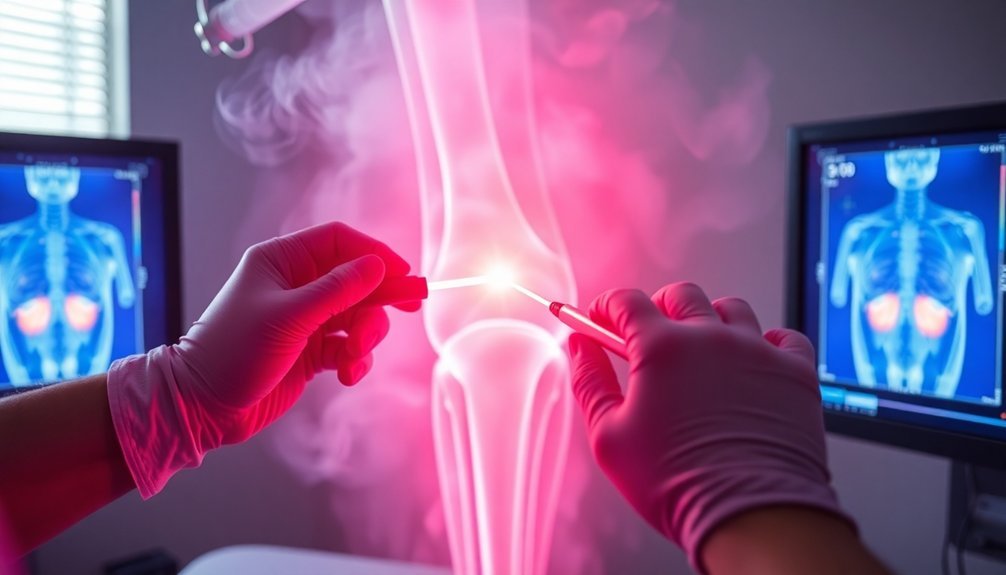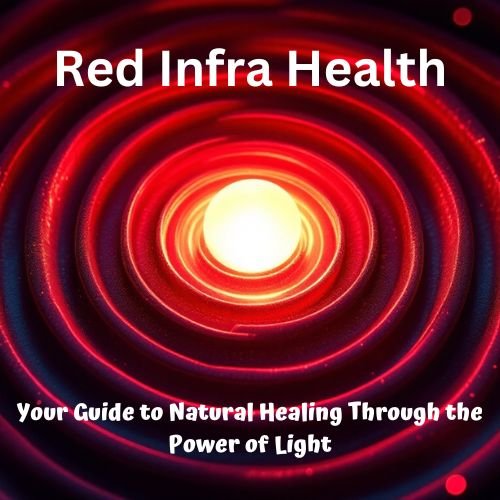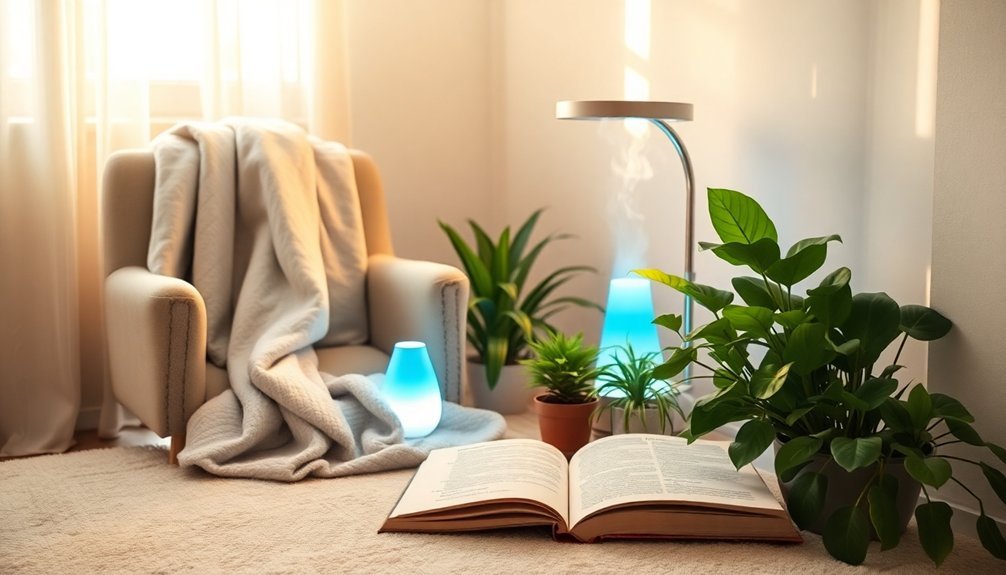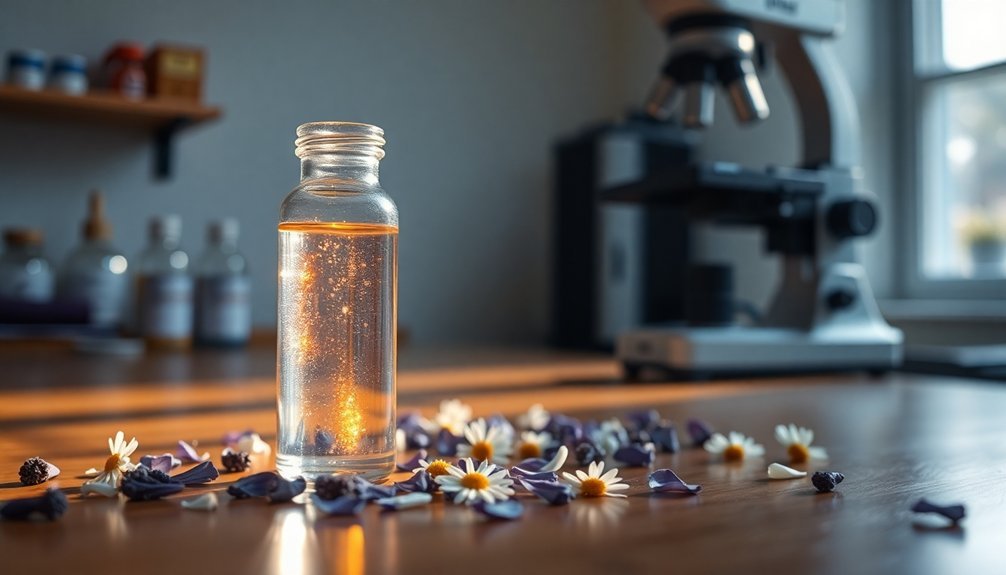Laser therapy sessions play a crucial role in managing your arthritis by stimulating your body's natural healing processes. When you undergo consistent treatments, specific light wavelengths penetrate your joints to boost cellular energy production, reduce inflammation, and trigger endorphin release for pain relief. You'll need 6-12 sessions, typically 2-3 times per week, to achieve superior results as the therapy gradually improves blood circulation and promotes tissue repair. Each 10-15 minute session builds upon the previous one, creating cumulative healing effects that can last 6-12 months. Understanding how these sessions work together will help you maximize your arthritis relief journey.
Targeting Pain With Light Waves

If you're seeking relief from arthritis pain, laser therapy offers a revolutionary approach that harnesses the power of light waves to promote healing. When low-level laser light penetrates your tissues, it stimulates cellular activity and triggers your body's natural healing processes.
This targeted treatment works by reducing inflammation, releasing endorphins, and improving blood circulation to affected areas. The treatment's benefits can be long-lasting for 6-12 months following a complete therapy course.
You'll find that laser therapy's mechanism of action is both sophisticated and effective. As the light waves interact with your cells, they promote anti-inflammatory responses by decreasing pro-inflammatory cytokines. The treatment also enhances blood flow, delivering essential oxygen and nutrients to damaged tissues while accelerating cellular repair. Through photobiomodulation, your immune response becomes better regulated, leading to faster healing.
What makes this approach particularly appealing is its proven effectiveness. Clinical trials show that consistent laser treatments can reduce arthritis pain by up to 70% compared to placebo treatments. You'll likely experience improved joint mobility and reduced morning stiffness – studies indicate a decrease of 27.5 minutes in morning stiffness for RA patients.
With both low-level and high-intensity options available, your practitioner can adjust the treatment specifically for your needs.
Science Behind Laser Treatment
Your body's cells respond powerfully to laser therapy, kickstarting a natural regeneration process that repairs damaged joint tissues.
The light waves penetrate deep into your joints, where they directly target inflammation and trigger the release of pain-relieving endorphins.
As the laser energy stimulates blood flow to your joints, you'll get more oxygen and nutrients delivered to the treatment area, which helps reduce swelling and promote healing. The therapy uses two specific wavelengths to provide both immediate pain relief and long-lasting inflammation reduction.
Cellular Regeneration Process
Understanding the cellular regeneration process behind laser therapy reveals its powerful healing potential for arthritis sufferers. When you undergo laser therapy, the treatment stimulates your cells' mitochondria, boosting ATP production and enhancing cellular metabolism. This increased energy helps your damaged tissues repair themselves more effectively.
The therapy works through multiple mechanisms to combat your arthritis symptoms. Your body's natural healing processes accelerate as the laser light increases blood circulation and oxygen delivery to affected areas. You'll experience pain relief as the treatment triggers endorphin release and reduces inflammation. Both LLLT and HILT options are available depending on the severity of your condition.
| Process | Mechanism | Benefit |
|---|---|---|
| ATP Production | Laser targets mitochondria | Increased cellular energy |
| Blood Flow | Enhanced circulation | Better oxygen delivery |
| Pain Control | Endorphin release | Natural pain relief |
| Inflammation | Immune response modulation | Reduced swelling |
| Cell Repair | Bio-stimulation | Accelerated healing |
Clinical studies support these benefits, with over 6,000 scientific articles documenting laser therapy's effectiveness. You'll find the treatment particularly beneficial for both osteoarthritis and rheumatoid arthritis, as it stimulates new cell growth while reducing morning stiffness and improving joint mobility.
Light Waves Target Inflammation
While inflammation wreaks havoc on arthritic joints, specific wavelengths of laser light work to counteract this damage through precise biological mechanisms. When you receive laser therapy, different wavelengths (660 nm, 808 nm, and 905 nm) penetrate your tissues at varying depths, targeting inflammation at its source.
The light waves trigger a cascade of cellular responses that reduce inflammatory markers and promote healing. This process involves light absorption by cytochrome C oxidase, a key enzyme in cellular energy production.
Your cells respond to laser therapy in three key ways:
- ATP production increases as the light stimulates cellular respiration and nitric oxide release, improving blood flow and cellular energy levels.
- Pro-inflammatory cytokines decrease while anti-inflammatory cytokines increase, creating a balanced immune response that reduces joint swelling.
- Gene expression shifts to favor anti-inflammatory pathways while suppressing inflammation-promoting genes.
The power density of the laser determines how deeply the therapeutic effects reach into your joints. Higher densities penetrate deeper tissues, which is vital for treating severe arthritis.
When multiple wavelengths are combined, as in MLS Laser Therapy, you'll experience enhanced anti-inflammatory and pain-relieving effects compared to single-wavelength treatments.
Circulation Boosts Joint Health
Blood flow dynamics play a crucial role in how laser therapy relieves arthritis symptoms. When you undergo laser treatment, the low-level light waves stimulate your blood vessels, triggering enhanced circulation throughout the affected joints.
This increased blood flow delivers essential oxygen and nutrients directly to your damaged tissues, kickstarting the natural healing process.
As your circulation improves, you'll notice several beneficial changes in your joints. The enhanced blood flow helps flush out inflammatory substances while stimulating your lymphatic system, which reduces swelling and pain. The therapy sessions are quick and efficient, typically requiring only 5-10 minutes of your time.
Your cells receive more nutrients and oxygen, enabling them to repair and regenerate more effectively. This boost in cellular activity leads to increased ATP production, your body's energy currency, which accelerates tissue healing.
You'll find that the improved circulation doesn't just provide temporary relief. Regular laser therapy sessions maintain this enhanced blood flow, creating a sustained healing environment in your joints.
The increased circulation continues to support your body's natural repair mechanisms, helping you maintain better joint mobility and experience less morning stiffness. This circulatory boost is a key reason why laser therapy effectively manages arthritis symptoms long-term.
Timing Your Sessions Right

Successful laser therapy for arthritis largely depends on proper timing and frequency of treatment sessions. You'll need a consistent treatment schedule, typically spanning 6-12 sessions, with each session lasting 10-15 minutes.
For chronic arthritis conditions, you'll benefit most from scheduling appointments 2-3 times a week to maintain steady pain relief and improved joint function. The therapy's anti-inflammatory effects work through the activation of your lymphatic drainage system, naturally reducing joint swelling.
Your treatment timing needs will vary based on whether you're dealing with an acute flare-up or managing chronic symptoms. For acute situations, don't delay – getting treatment within 24-48 hours can substantially reduce inflammation and recovery time.
- Schedule initial treatments close together (2-3 times weekly) to build a cumulative healing effect
- Maintain regular sessions for chronic arthritis management to prevent symptom recurrence
- Plan for ongoing maintenance sessions to sustain long-term pain relief and joint mobility.
Frequency For Best Results
Following the right treatment schedule leads directly to the ideal frequency for your laser therapy sessions. If you're dealing with acute arthritis, you'll need more frequent treatments initially – about 2-3 times weekly for 2-3 weeks. For chronic conditions, you'll start with 1-2 sessions per week, gradually reducing frequency as you improve. The therapy's unique synchronization approach helps deliver consistent and efficient pain relief through its combined continuous and pulsed emissions.
| Condition Type | Initial Frequency | Duration |
|---|---|---|
| Acute Arthritis | 2-3x per week | 2-3 weeks |
| Chronic Arthritis | 1-2x per week | 4-6 weeks |
| Severe Flare-ups | Daily/Every other day | 2-4 weeks |
| Maintenance | Monthly | As needed |
You'll notice improvements as you follow these protocols, which typically range from 6-12 treatments over 2-6 weeks. Your healthcare provider will adjust your frequency based on how you respond to the therapy. Daily treatments might be recommended for severe cases, while others may benefit from every other day sessions. The key is consistency – your treatment plan will evolve as your condition improves, potentially moving from frequent initial sessions to periodic maintenance visits that help prevent inflammation from returning.
Long Term Benefits

Research confirms that laser therapy offers lasting relief for arthritis patients, with studies showing up to 70% reduction in chronic pain through consistent treatment. When you commit to regular sessions, you'll experience improved joint mobility and reduced inflammation without the side effects common in traditional treatments like steroid injections.
The long-term advantages of laser therapy are particularly compelling, as it addresses arthritis at the cellular level while providing sustainable pain management. The therapy promotes ATP synthesis rates in affected joint tissues, accelerating the healing process. You'll benefit from photobiomodulation, which enhances your body's natural healing processes and promotes lasting joint health.
Here are the key long-term benefits you can expect:
- Sustained pain relief through endorphin release and blocked pain signals, reducing your dependence on pain medications
- Improved joint function and mobility, with noticeable reductions in morning stiffness and increased tip-to-palm flexibility
- Long-lasting reduction in inflammation and swelling, supported by enhanced blood circulation and cellular repair
Unlike many conventional treatments, laser therapy's benefits accumulate over time, leading to better overall joint health and function. You'll experience these improvements without worrying about adverse effects, as over 3,000 scientific studies have confirmed laser therapy's safety and effectiveness.
Healing At Cellular Level
The fascinating process of laser therapy occurs deep within your body's cells, where specific wavelengths of light trigger a cascade of healing responses. When you undergo laser therapy, your cells absorb the light energy, which stimulates increased ATP production – the essential fuel that powers cellular repair and function.
Through a process called photobiomodulation, the therapy enhances your body's natural healing mechanisms. You'll experience improved blood circulation, which delivers more oxygen and nutrients to your arthritic joints.
The laser light also stimulates your mitochondria, the powerhouses of your cells, leading to enhanced cellular metabolism and faster tissue repair.
What's particularly remarkable is how laser therapy affects your immune system. It modulates your body's inflammatory response while triggering the release of endorphins – your natural pain-fighting compounds.
The therapy also reduces oxidative stress in damaged cells and promotes lymphatic drainage, which helps decrease swelling in your joints.
Scientific evidence strongly supports these cellular benefits, with over 6,000 published articles documenting the effectiveness of laser therapy. Clinical trials consistently show that these cellular-level changes translate into significant improvements in arthritis symptoms, with an impressive 85-90% efficacy rate.
Treatment Duration Guidelines

You'll need different session lengths based on whether you're treating acute or chronic arthritis, with acute conditions typically requiring 4-6 sessions and chronic cases needing 6-12 or more treatments.
For the best results, you should receive daily treatments for two weeks, or you can opt for every-other-day sessions over 3-4 weeks.
Each treatment session should last between 20 and 300 seconds, with minimum doses of 4 Joules for knee medial and 6 Joules for hip conditions.
Session Length By Type
Laser therapy sessions for arthritis follow specific duration guidelines based on whether you're treating acute or chronic conditions. While most treatments last between 10 to 15 minutes, your session length can vary from 3 to 20 minutes depending on the size of the treated area and severity of your condition.
For acute arthritis, you'll typically need 6 sessions spread over 2-3 weeks, with treatments scheduled 2-3 times per week. If you're dealing with chronic arthritis, your treatment plan will likely extend to 12 sessions over 6 weeks, maintaining the same 2-3 times weekly frequency. You might also need periodic maintenance sessions to control long-term symptoms.
Here's what determines your specific session length:
- Treatment area size – larger joints or multiple areas require longer sessions
- Condition severity – more severe symptoms may need extended treatment times
- Type of arthritis – chronic conditions often require longer treatment durations than acute cases
You won't feel pain during these quick, convenient sessions, and many patients report improvements after their first treatment. While shorter wavelengths and longer administration times may enhance effectiveness, your healthcare provider will determine the ideal duration for your specific case.
Frequency For Best Results
Getting the best results from laser therapy requires a carefully structured treatment schedule. For chronic arthritis, you'll typically need 2-3 sessions per week during the initial phase of treatment.
Your healthcare provider will assess your condition and develop a personalized plan that considers your specific type of arthritis and its severity.
During the first 2-4 weeks, you'll likely undergo more frequent treatments to establish a strong foundation for pain relief and healing. As you begin experiencing improvements, your treatment frequency may gradually decrease.
For ongoing maintenance, you might shift to weekly sessions to sustain the benefits and manage inflammation.
You'll find that consistency is key to achieving the best results. If you're combining laser therapy with other treatments like physical therapy or medication, your schedule might need adjustments to maximize the therapeutic effects.
Your provider will monitor your progress regularly and modify the frequency based on your response to treatment.
Remember that while some patients see improvements quickly, others may need longer treatment periods. Don't get discouraged if your treatment plan differs from others – it's designed specifically for your condition and healing needs.
#
Recovery Between Treatments
Between laser therapy sessions, you'll experience minimal downtime since the treatment is non-invasive and gentle on your joints. You won't need extensive recovery periods, allowing you to maintain your daily activities while undergoing treatment.
The therapy's design enhances your body's natural healing processes, promoting cellular repair and improved circulation without causing additional stress to your arthritic joints.
Your recovery between treatments benefits from laser therapy's ability to:
- Accelerate cellular repair and modulate your immune response, reducing inflammation naturally without medication
- Enhance blood circulation, delivering more oxygen and nutrients to your affected joints for faster healing
- Support other ongoing treatments by complementing physical therapy and improving joint mobility
Each session lasts just 10-15 minutes, and you'll typically receive treatments 2-3 times per week as part of a thorough plan. Since there's little to no sensation during the procedure, you can easily integrate these sessions into your schedule.
If you have chronic arthritis, you may need periodic maintenance sessions to sustain the positive effects, but your treatment plan will be tailored to your specific needs and comfort level.
Managing Multiple Joint Pain
Modern pain management strategies have revolutionized the treatment of multiple joint pain through the application of laser therapy. If you're struggling with pain in several joints, you'll find that laser therapy offers a thorough solution through its synchronized wavelength emissions of 808nm and 905nm, which work together to target multiple affected areas.
When you undergo laser therapy for multiple joint pain, you're benefiting from several healing mechanisms simultaneously. The treatment stimulates your body's natural repair processes by increasing ATP production and enhancing blood circulation to deliver essential nutrients to all affected joints.
You'll notice reduced inflammation as the laser promotes anti-inflammatory cytokine production, while also experiencing pain relief through the therapy's ability to block pain signals to your brain.
What makes laser therapy particularly effective for managing multiple joint conditions is its non-invasive nature and lack of side effects. You won't need to worry about surgical interventions or medication interactions. Instead, you'll receive controlled energy delivery that minimizes thermal damage while maximizing therapeutic benefits.
The treatment's cumulative effects mean you'll experience sustained relief across all treated joints, making it an ideal choice for ongoing arthritis management.
Measuring Progress Through Sessions

Throughout your laser therapy journey, tracking progress requires systematic monitoring using established assessment tools and protocols. You'll notice improvements through standardized measurements like the visual analog scale (VAS) for pain intensity and specific functional assessments that evaluate your joint mobility and daily activities.
To effectively measure your progress during laser therapy sessions, you'll want to focus on these key indicators:
- Pain reduction measurements: Your therapist will track your pain levels using VAS scores before and after each session, helping you understand the cumulative benefits of treatment over time.
- Functional improvements: You'll see progress in your ability to perform daily activities, including longer walking times and better joint flexibility, especially during morning hours when stiffness typically peaks.
- Range of motion gains: Regular assessments of your joint mobility will demonstrate improvements in flexibility and movement capabilities, particularly when following WALT-recommended protocols with specific wavelengths and dosages.
Your progress tracking should continue through follow-up periods of 1-12 weeks after treatment, as the benefits of laser therapy are often sustained and build upon each session.
This systematic monitoring helps confirm you're receiving the most effective therapeutic dose for your specific condition.
## Recovery Between Treatments
You'll need a personalized treatment plan that accounts for your arthritis severity and response to laser therapy, with most patients receiving 2-3 sessions per week.
Your recovery between treatments typically involves minimal downtime, though you might experience temporary warmth or mild discomfort as part of the healing process.
While some patients notice immediate improvements, others may need 4-6 sessions before seeing significant results, making it essential to track your progress and communicate with your healthcare provider about adjusting the treatment schedule.
Building Your Treatment Plan
Getting the most out of laser therapy requires careful attention to recovery periods between treatments. When you're building your treatment plan, you'll work with your healthcare provider to develop a strategy that maximizes healing while preventing overexposure.
Your personalized plan will consider factors like your arthritis severity, overall health condition, and specific pain points.
Your treatment schedule typically follows a structured approach that allows for proper cellular response and healing between sessions. You'll likely need:
- 3-5 weekly applications, carefully spaced to optimize healing responses
- A 3-4 week initial treatment course, with adjustments based on your progress
- A 2-3 week rest period before starting another treatment cycle
During your therapy, you'll receive a combination of techniques, including low-level laser therapy and photobiomodulation, targeted specifically to your affected areas.
Your provider will adjust the laser parameters – including wavelength, intensity, and duration – as your condition improves. This approach integrates well with other treatments you might be receiving, such as medication or physical therapy, creating a thorough strategy for managing your arthritis symptoms and promoting long-term joint health.
Understanding Recovery Timeframes
Successful laser therapy for arthritis relies heavily on proper recovery periods between treatments. You'll typically receive treatments 2 to 3 times per week, with each session lasting 10 to 15 minutes. Your body needs this spacing to adapt to the therapy and maximize healing benefits.
Your treatment schedule will start gradually, with shorter sessions that build up to full intensity. This approach helps prevent pro-inflammatory responses and allows your immune system to adjust properly.
Between treatment courses, you'll need rest periods of 2 to 3 weeks for ideal recovery.
The effects of laser therapy are cumulative, and you may notice improvements immediately or after your third session. For chronic arthritis, you'll likely need 6 to 12 sessions, and some cases require ongoing maintenance treatments.
Your orthopedic specialist will create a personalized plan based on your condition's severity.
You can combine laser therapy with other treatments like physical therapy and medication for thorough management. While individual responses vary, consistent treatment following proper recovery timeframes can lead to long-lasting results, including reduced pain, improved joint mobility, and decreased morning stiffness.
Light Wavelength Impact

Understanding the impact of light wavelength is essential for effective laser therapy in arthritis treatment. When you're receiving laser therapy, different wavelengths penetrate your tissues at varying depths, directly affecting the treatment's success.
Wavelengths between 660 nm and 905 nm have proven most effective, with longer wavelengths reaching deeper tissues and shorter ones targeting surface areas.
The specific wavelength choice matters significantly for your arthritis treatment outcomes. Clinical studies have shown that properly selected wavelengths can:
- Reduce morning stiffness and improve joint mobility
- Decrease inflammation in targeted areas more effectively
- Provide longer-lasting pain relief when used consistently
Your healthcare provider will select the most appropriate wavelength based on your specific condition and treatment goals. For instance, if you're dealing with deep joint pain, they'll likely use wavelengths around 905 nm for better tissue penetration.
Surface-level joint issues respond better to shorter wavelengths near 660 nm. This precision in wavelength selection isn't just a technical detail – it's vital for achieving the best results in managing your arthritis symptoms while ensuring the therapy's safety and effectiveness.
Customizing Your Treatment Plan
Beyond selecting the right wavelength, your laser therapy treatment plan must be carefully tailored to your specific needs. Your practitioner will consider multiple factors, including the severity of your arthritis, the affected areas, and your overall health condition to determine the most effective approach.
Treatment duration typically ranges from 5 to 20 minutes for Class IV laser therapy, while BioFlex sessions run longer at 30 or 45 minutes. You'll likely need between 3 to 10 sessions, though chronic cases might require up to 20 treatments. Your specialist may start with shorter sessions to help your immune system adjust gradually.
To maximize results, you might benefit from combining laser therapy with other treatments. Your practitioner may recommend incorporating physical therapy, custom orthotics, or lifestyle modifications like an anti-inflammatory diet and stress management techniques.
This thorough approach can enhance your body's healing response and provide more effective pain relief.
Your treatment plan isn't set in stone – your practitioner will continuously monitor your progress and adjust parameters such as wavelength, intensity, and frequency based on how you respond to the therapy.
Frequently Asked Questions
Can I Continue Taking My Arthritis Medication During Laser Therapy Sessions?
Yes, you can continue taking your arthritis medication during laser therapy. Studies show they work well together, and there aren't any significant interactions. The combination may actually enhance your overall pain relief and treatment results.
Does Insurance Typically Cover Laser Therapy for Arthritis Treatment?
Insurance coverage for laser therapy varies widely. While Medicare and some private insurers cover low-level laser therapy, many don't cover Class IV lasers. You'll need to check directly with your provider for specific coverage details.
Is Laser Therapy Safe to Use With Metal Joint Replacements?
Yes, you can safely receive laser therapy with metal joint replacements. It doesn't generate heat or interact with metal implants, and your therapist will adjust settings as needed to guarantee safe, effective treatment around your replacement.
Are There Age Restrictions for Receiving Laser Therapy Treatment?
You won't face specific age restrictions for laser therapy treatment. While it's commonly used for older adults with arthritis, you'll need an individualized treatment plan based on your health status, regardless of your age.
Can Laser Therapy Help Prevent Future Arthritis Flare-Ups?
Yes, you'll find laser therapy can help prevent future flare-ups by reducing inflammation and accelerating tissue repair. It's shown to extend remission periods and provide long-term relief when you receive regular treatments.
In Summary
You'll see the most significant arthritis relief when you stick to your prescribed laser therapy schedule. By tracking your progress and working with your therapist to adjust wavelengths and treatment frequency, you're setting yourself up for long-term success. Don't skip sessions – each treatment builds upon the last. Remember, laser therapy isn't a quick fix, but with consistent sessions, you'll experience lasting pain reduction and improved mobility.





Leave a Reply